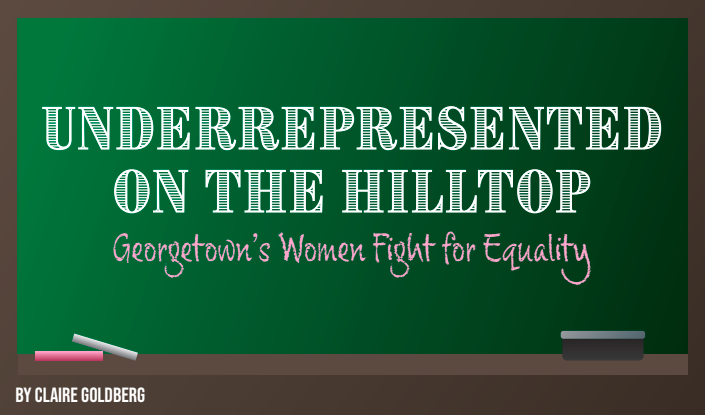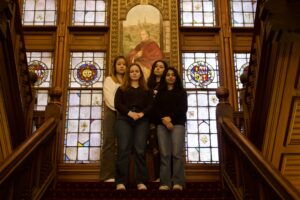Georgetown University’s Board of Directors, which governs the university and makes decisions regarding tuition, academic programs, and other university policies along with President John DeGioia, is composed of nine women and 32 men. The board’s executive committee has 12 men, and two women. The executive committee’s compensation subcommittee has four members, all of whom are men. The board’s faculty relations subcommittee has six members, all of whom are men.
The athletics committee has one female member, Kathleen Hugin (COL ‘82), out of seven. The law center affairs committee has seven members, all of whom are men, though the majority of law students students nationwide and at Georgetown University are women.
Georgetown University only has one administrative committee with near-equal numbers of men and women: the strategic development and advancement committee, chaired by Laurie Hodges Lapeyre. There is one more man than woman on the membership list.
Of Georgetown’s 12 deans, one for each school and three for the Medical Center, ten are men. According to U.S. News & World Report, Georgetown’s undergraduate population is 56 percent female.
The Office of Assessment and Decision Support provides data from 2011-2015 regarding the racial and gender makeup of faculty and staff, but does not break them down by department or type of faculty. According to this data, as of fall 2015, there were 955 female faculty members, 1,238 male faculty members, and 261 faculty members of unknown gender. The data also shows that there were 156 Asian faculty members, 90 black faculty members, 609 faculty of unknown race, and 1,360 white faculty members.
Although women at Georgetown have some distance to go before they see equal gender representation in faculty and administration, they have not stopped striving. Female student and university leaders have shown concern for representation and have begun the work of tipping the scales towards equality.
Professor Marcia Chatelain teaches in the history department, where there are 27 male and 15 female professors, and in the African-American studies department, where there are 16 male and 11 female professors. She says she came to Georgetown in part because she felt it was a place female employees could thrive. But she acknowledges that Georgetown is not as diverse as it could be.
“Georgetown is not immune to the structural and social issues that get in the way of achieving a diverse faculty, staff, and student body across units and disciplines,” Chatelain wrote in an email to the Voice. “Every college and university in this country has a long way to go in terms of true and meaningful diversity.”
University spokesperson Rachel Pugh said the university is working toward gender equality in upper-level hiring practices.
“Georgetown is deeply committed to gender equity and is preparing to launch a Presidential Task Force on Gender Equity with a focus on faculty and senior administrators,” Pugh wrote in an email to the Voice. “We are committed to continuing to recruit the very best and most talented students, faculty and staff and to ensuring that our faculty and senior administrators reflect the diversity of our community.”
Some of Georgetown’s academic departments are also individually pursuing the practice of hiring more women and minorities. This year, the government department hired Jamil Scott, an African-American woman who recently received her Ph.D. from Michigan State University. As of now, there are 51 male professors and 20 female professors in the department, not including Scott. She’s slated to start in the fall.
Some students have noticed a lack of representation in faculty and administration. “One of the spaces where I see a little bit of gender inequality is just in the range of the professors I have,” said Nicole Heitsenrether (SFS ‘19), a deputy co-chair of the Own It Summit, a day-long event focused on women’s empowerment. “Especially kind of being in the SFS, a lot of my professors have been male. Even this semester four out of five of my professors are male. It doesn’t necessarily say anything about the hiring practices here, but I have seen a lack of women professors throughout my time here.”
Isatou Bah (COL ‘20), who is the operations chair of the student club Georgetown University Women in Leadership (GUWIL), also spoke to the need to hire women and people of color, explaining that improved gender and racial diversity helps students to feel more connected to staff and faculty.
“Black and qualified women exist who can fulfill those roles, so the most logical next step is to hire them,” Bah said. “I know women out there with the experience who want to be deans. So let’s just hire them.”
Laura Kovach, director of the Women’s Center, noted the importance of thoughtful hiring practices at Georgetown.
“Like any organization, it’s imperative that we review our recruiting and hiring practices to make sure they are equitable and diverse,” Kovach said. “The next step is to put into practice the hiring of diverse women into leadership and faculty roles. I hope Georgetown continues to reflect upon and pursue this practice.”
In student life at Georgetown, many organizations are working to diversify their membership. The Corp has altered its application process in a move to hire more students of color, while Blue & Gray are working to include students of a variety of backgrounds, including religious and gender identification. There are also various groups that exist for the purpose of furthering gender and racial equality, such as the Center for Multicultural Equity and Access and the Women’s Center.
Pugh noted that several university organizations exist to help promote gender equality and diversity, including the Georgetown Institute for Women, Peace, and Security, as well as the Georgetown Women’s Alliance. Lisa Krim, a senior advisor to the president and chair of the Georgetown Women’s Alliance steering committee, said that the alliance was formed from an energy in the community and a need for more organized communication within already-existing women’s organizations.
C.C. Borzilleri (COL ‘18) is a fellow for the alliance, where she works on programming and offers student input in faculty decision-making. The purpose of the alliance is to promote dialogue and create a network for women on campus, including faculty and staff, and, as Borzilleri wrote in an email to the Voice, to promote gender equality.
“Gender issues at Georgetown are a work in progress, and there is certainly room for lots of improvement,” Borzilleri said. “But [campus] resources are a band-aid to the symptoms of the problem of gender inequality on campus. What we need is a permanent solution to address the underlying causes of this inequality. There is a pervasive culture of tendencies across campus that put women at a disadvantage, and it requires active management by the whole community to change this situation for women.”
Borzilleri sees hope for women both on campus and throughout the country.
“Though the situation is unfortunate that there is a culture of unequal treatment between women and men, I am inspired by the energy across campus and the nation from women ready to make a difference,” Borzilleri said.
The Own It Summit is one example of a campus initiative to combat gender inequality, founded for women and by women. The summit staff haved pushed to include a more diverse group of women in the past few years. Heitsenrether, one of Own It’s deputy co-chairs, said that though the board of the summit is open to people of all genders, this year it is made up entirely of women. The summit also has a “man-bassador” program to encourage men to make efforts for female empowerment.
“I think it’s very helpful to have spaces and groups that are putting women’s issues at the forefront of what they’re doing,” Heitsenrether said.
GUWIL, which works to promote professional development for women, recently made an effort to include more women of color. Bah said she gained her role on the executive board in part due to this effort.
“What GUWIL is doing is great because they’re actually making an effort to reach out to other people, starting with me and other black girls on campus,” Bah said.
Lauren Stricker (SFS ‘18), who is GUWIL’s executive president, admits that the organization has a history of lacking diversity. She also discussed the reasoning for choosing Bah as a member of the board.
“As a board we have been fully aware of the reality that GUWIL remains a predominantly white organization,” Stricker said. “[Bah] acknowledged GUWIL’s problems in a lack of diversity and had impressive ideas about how to improve GUWIL so it is accessible to all members of Georgetown. We also talked openly about how important representation in leadership is to creating a positive image of the organization as a whole; we cannot expect our membership to become more representative if our board is not, too.”
But even though student clubs and some academic departments are working toward diversifying staff, Chatelain believes it must be reflected on a larger scale.
“I appreciate that my colleagues and the administration are devoting time and resources into investigating this problem here,” Chatelain said. “And hopefully we can become leaders in helping our peers not only reduce discrimination but also work toward a world that eradicates gender-based discrimination.”
Anne Paglia contributed reporting.







How could you write this story without examining the makeup of the student body? Hiding those numbers was purposeful, since the effects of misandry are apparent in the demographics of those who attend.